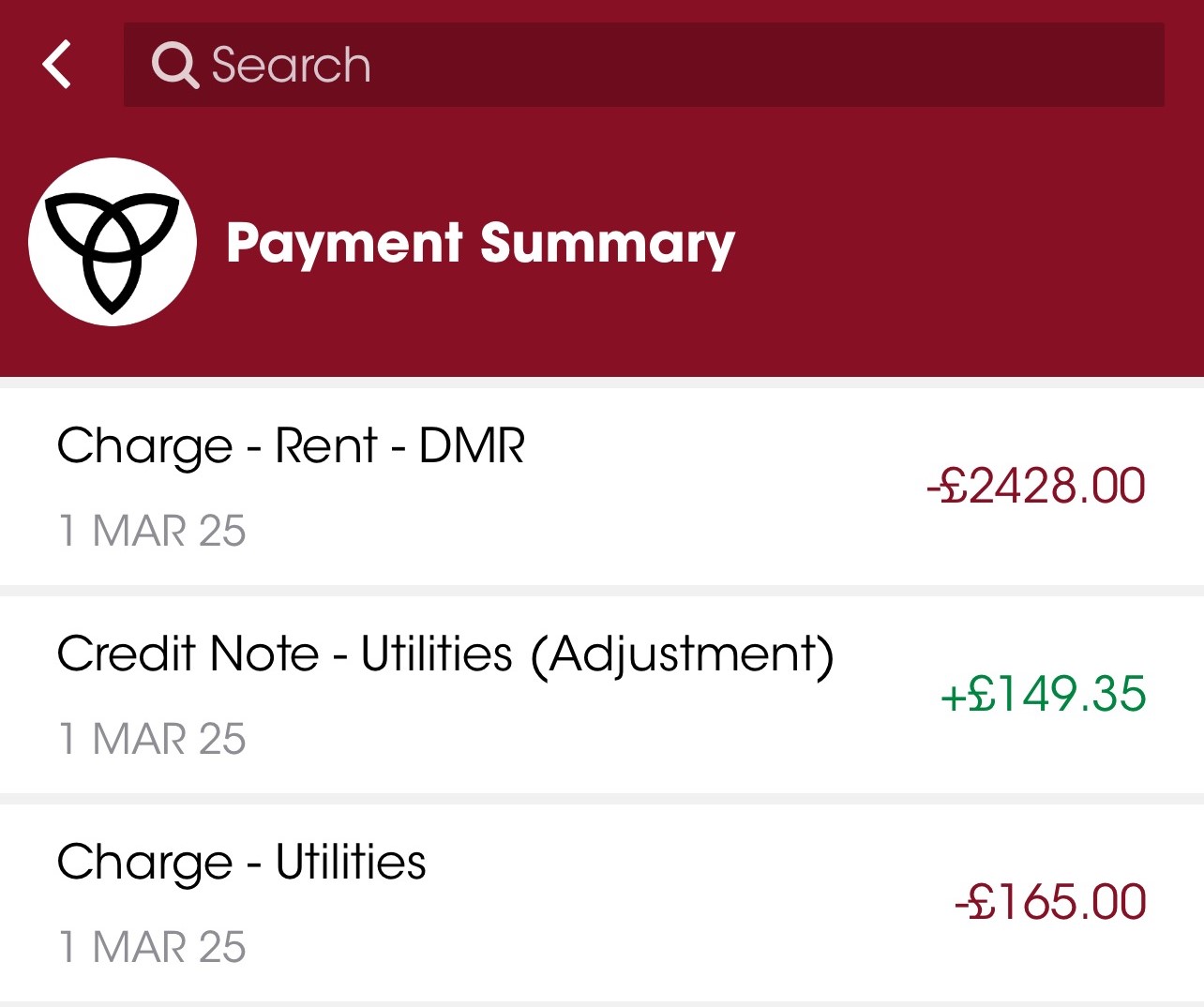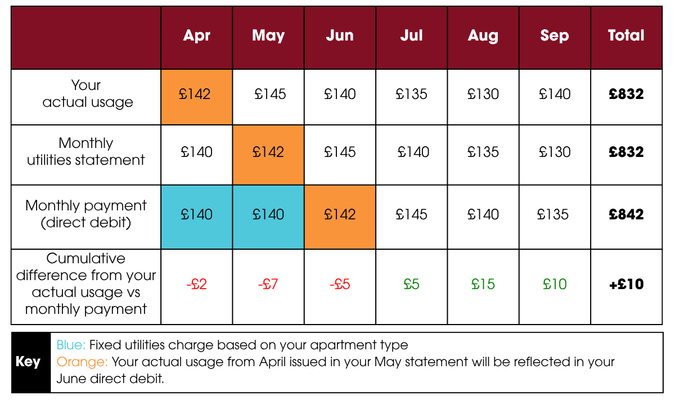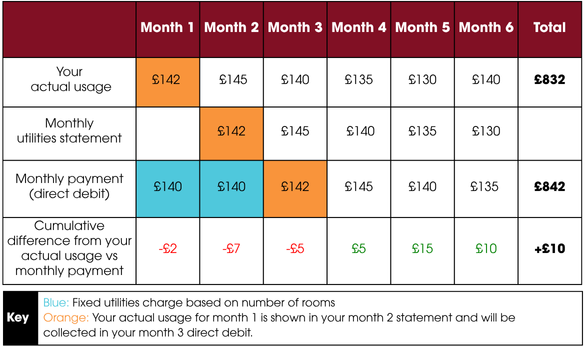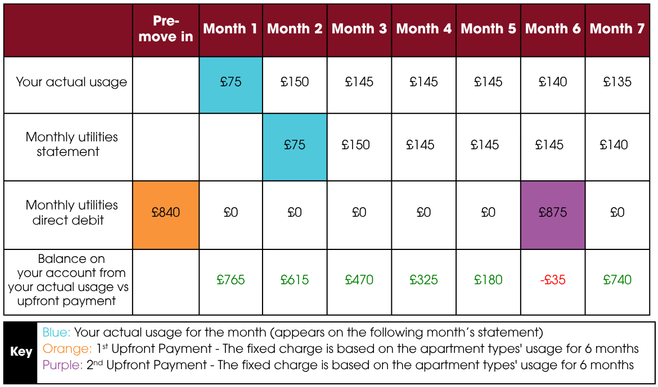EVERYTHING YOU NEED TO KNOW ABOUT YOUR UTILITIES AND RECONCILATIONS
Here are some common questions and answers about your utilities and monthly reconciliations. Take a look and if you have any questions, you can find contact details at the bottom of the page.
Our utilities are managed by Community Utilities, a utilities billing agent, operating on behalf of residential buildings like ours across the UK. They manage the day-to-day aspects of your utilities, including queries related to your consumption, statements, meter readings and the utilities portal. They’ll tell us what to charge you, and we will pass this payment on to you as part of your monthly or upfront rent payments if you decide to pay upfront.
Back To TopYour utility charges include electricity, heat, and water, including the costs of cold water, hot water, heat, and wastewater. You’ll be charged in pence per unit (kWh) of fuel for electricity/heat, with a daily standing charge in pence per day. For water, you'll be charged in pounds per unit of water (m3) with a daily standing charge in pence per day.
Back To TopOn 1 April of every year, we secure a new 12-month fixed-term agreement. The annual rates (for unit and standing charges) are based on several factors, including the cost of energy purchased during the fixed period and these are agreed with our energy partner.
Back To TopWe operate a District Heat Network, which means we have a single plant, piping hot water to taps and radiators across multiple buildings. This system is required under local planning regulations as the most energy-efficient way to heat large developments. Unlike individual gas boilers, our network provides a fully managed heating service, so you don’t have to worry about installation, maintenance, or repairs - just turn on the tap or adjust your thermostat.
Price comparison sites like Uswitch show the price for gas only, which is a very different service as it doesn’t include the full cost of heating and hot water services. The Heat Trust – while we are not an official member – is an independent, non-profit consumer champion for heat networks in the UK, and it provides a calculator which we use to benchmark our pricing. While our heat unit rate is increasing, our calculations show that our average annual costs across all Quintain Living buildings remain lower than the best available in the market.*
*Calculated using the Heat Trust Calculator. The average annual usage for heating and hot water across all unit types in Quintain Living developments in 2024 was 2,652 kWh p/year, equating to £615 p/year using the calculator. This is compared to The Heat Trust's estimate for gas central heating, using the same usage is £733 per year. Prices were calculated as of 31 March 2025.
Back To TopA standing charge (or shown as a metering charge on your monthly statements) is a fixed daily amount every UK resident must pay for energy and water, no matter how much you use. Every apartment pays the charge, and it covers the costs our energy supplier takes on to get you your energy. Think of it like a line rental but for your energy rather than your phone.
Back To TopWater and wastewater bills in the UK are increasing primarily due to significant investments to upgrade ageing infrastructure and improve environmental standards. These increases are intended to fund essential projects, such as reducing sewage discharges into rivers and coastal waters.
According to MoneySavingExpert, the average UK water bill is expected to rise by £126 annually (26% increase).* For water, you will pay an average of £99 more annually (34% increase). So, whilst our percentage increase is higher, the reality is that what you are paying is £30 less annually than the average UK water bill. But remember, your exact charge will depend on how much water you use. The Energy Saving Trust offers some easy and small tips you can incorporate into your daily habits to help lower your bills and benefit the environment.
* MoneySavingExpert, Water bills to rise from April 2025, Created 19 December 2024, Last edited 30 January 2025
Back To TopThe energy price cap that protects domestic households from high energy (electricity and gas) costs doesn't apply to us as our set-up is classified as ‘commercial’, not ‘domestic’. This was chosen at the development stage to provide competitive tariffs for residents as well as manage all utilities under one bill.
As residents, you benefit from a 12-month fixed-term tariff for utilities, which is currently cheaper than the energy price cap for electricity unit rates (27.03p/kWh).² Unlike the energy price cap, which updates every 3 months, our tariff remains consistent for a full year. This protects you from fluctuations in the market, even during periods when the domestic market may see significant price increases due to shifts in underlying energy costs.
Our heat tariffs are not comparable to gas, but as mentioned above our average annual costs for heat and hot water are lower than the best market rates, according to The Heat Trust.¹
¹ Calculated using the Heat Trust Calculator. The average annual usage for heating and hot water across all unit types in Quintain Living developments in 2024 was 2,652 kWh p/year, equating to £615 p/year using the calculator. This is compared to The Heat Trust's estimate for gas central heating, using the same usage is £733 per year. Prices were calculated as of 31 March 2025.
² Ofgem, Changes to energy price cap between 1 April and 30 June 2025, 25 February 2025.
Back To TopIf you want to work out your current spending on the new tariff, you can do so by doing these calculations using your latest energy bill. Here is an example of what your monthly statement looks like. You can use your rates found on your monthly statements to calculate all your standing and utilities charges (e.g heat, electricity, water) and get a total for the month.
 Back To Top
Back To Top
- Quarterly reconciliations until 31 March 2025: We will apply a fixed utilities charge to your monthly direct debit based on the average usage for your type of the apartment, we then reconcile your actual usage quarterly. Your last quarterly reconciliation for January – March usage will be applied to your June direct debit. To help you tell the difference between the payments in the ‘Payment Summary’ of your resident app, your reconciliation will be labelled as ‘Charge - (Adjustment)’, while your monthly payment will appear as ‘Charge – Utilities.’

- Monthly reconciliations from 1 April 2025: We will begin to set your monthly utility charge based on your actual usage, with each month’s direct debit including the usage from the previous month's statement. See the next question for more information.
For residents who pay rent monthly and who moved in before 31 March 2025:
We will apply the fixed utility charge as usual to your April and May direct debits based on your apartment type. Starting from June, your direct debit will reflect your actual usage from April, based on the information in May’s utilities statement. We have created a handy table below to explain how this will work below.

For new residents who have just moved in
For the first 2 months, your direct debit will be a fixed utilities charge based on your apartment type. In month 3, you will be charged based on your actual usage from month 1, based on the information shown in your month 2 statement. We have created a handy table below to explain how this will work below.

For residents who decide to pay rent upfront only (this example is 6 months upfront):
Your upfront payment is calculated using a fixed charge based on the average utility usage for your apartment type. This payment is made in advance to cover 6 months, and as you use utilities each month, the balance gradually decreases.
At the end of each 6-month cycle, a new upfront payment is calculated on the same basis. Any remaining credit or outstanding balance is rolled into the next upfront payment or settled with your deposit, ensuring your account stays balanced over time.
For example, if your fixed utility charge is £140 per month, your initial upfront payment for 6 months would be £840. You can find an example below.
 Back To Top
Back To Top
As mentioned in the ‘How do I pay for my utilities’ questions, your monthly utilities charge shows each month in your resident app as ‘Charge – Utilities’ and for those residents who moved in before 31 March your last quarterly reconciliation will show as ‘Utilities – Adjustment’ in the ‘Payment summary’ of your resident app.
 Back To Top
Back To Top
Head to 'My account' > 'Payment summary' to see your recent charges and payments.
Back To TopIf you’re the lead resident (primary resident on the tenancy), you can access your statements in the Community Utilities portal here. Your latest statement is typically available for you to view in the portal around the middle of the month for the previous month's usage. For example, February’s statement will be available in mid-March. In addition to this, the lead resident will also receive a copy of the statement when it’s ready via email from Community Utilities.
If you’re a new resident, the lead resident will receive an email with a link to register for an account within 2 weeks of moving in. If you’re having trouble accessing your account or have not received a link to register, please get in touch with Community Utilities at [email protected].
Community Utilities will be managing your statements and readings from 1 April. They will only use estimate readings when, unfortunately, there is an issue with any of your meter data at the beginning or end of each month. The estimates used are based on your previous average usage of your apartment type, and they will never estimate on heat. The aim is that your statement reflects your actual usage, so please rest assured that we are working with Community Utilities to take the necessary actions to fix any issues that are preventing us from billing on actual readings. Once we have actual readings, any difference between your estimate and actual readings will be reflected in your statements. Below is an example of how you can tell from your statement if we have used estimated readings.

Your monthly statements include VAT where applicable. VAT at 5% applies to electricity, heating and hot water. VAT is not charged on fresh and wastewater. Keep in mind that when comparing with online or news sources, prices may sometimes be displayed without VAT.
Back To TopYour meter only provides one daily read to the supplier and therefore it is not possible to provide a day/night rate as they are not able to apportion the usage to the correct time period. Instead, your rate is blended so the cheaper night element of the rate is blended into the day rate, reducing it and creating a lower flat overall rate. This means that you get some of the benefit of the cheaper night rate for any usage in the day. As an example, although you may not get a cheaper rate for doing your washing at night, all of your daytime usage is cheaper because of this.
Back To TopYou can't change supplier as the energy set up at Quintain Living is with a commercial supplier and the metering infrastructure on site doesn’t give residents the option to choose their supplier. This set-up was chosen at the development stage to provide competitive tariffs for residents as well as manage all utilities under one bill. This means you do not need to search for the best energy deals, pay multiple suppliers and manage multiple utilities. In addition, your utilities are already set up when you move in and will end when you move out to make things easier for you.
Back To TopThe energy and water usage for your apartment will be taken as part of your single rent and utilities Direct Debit payment. You’ll need to settle any costs among your flatmates separately.
Back To TopMaking just a few small changes in your home can have a big impact on your energy bills and can help you save money. Don’t forget to check out the MoneySavingExpert saving tips here.
Back To TopFinal meter readings and any pending quarterly reconciliations will be taken into account as part of your move-out process and your final end-of-tenancy balance will be calculated using these. If you’re in credit after your final bill, we will arrange for this to be refunded to you. Alternatively, if you owe us money, a charge will be raised on your account and the payment will be deducted from your deposit (if applicable) or settled by a payment link or bank transfer.
Back To Top- For utilities-based queries such as usage, amount shown on your statements, metering issues, or issues accessing the utilities portal:
- Community Utilities will be your main point of contact. You can contact them via [email protected]
- For issues with your water, heat, or electricity supply:
- Please let your Maintenance team know by ‘Reporting an issue’ in your resident app under ‘My apartment’
- For urgent issues, call us on 0203 219 2165 as soon as you can so we can investigate
- For queries with payments such as a recent direct debit or balance on your account
- Please contact our Accounts team at [email protected] or ‘Report an issue’ via your resident app under ‘Utilities’ then ‘Statements/charges’







